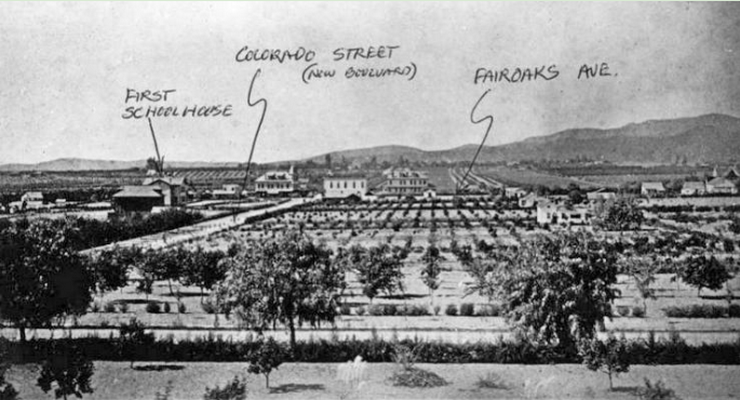
Looking west towards the intersection of Colorado Boulevard and Fair Oaks Ave in the 1880’s. [Image courtesy Pasadena Museum of History]
In 1886, the year Pasadena was incorporated, the city was experiencing major “growing pains,” according to Macneil.
Following the completion of the railway to Pasadena, the population of the community had increased from fewer than 400 residents in 1880 up to nearly 5,000 residents in 1890.
“Pasadena was attracting a diverse population. Some were rich, well traveled and sophisticated and came to Pasadena for its beauty, enjoying Pasadena first as a winter resort, then establishing a home here.”
“Many others from all walks of life came here for the opportunities that a fast growing community provides. New arrivals appreciated the community and many decided to stay and make the Crown City their home. They found employment, raised their families, and became part of the community.”
Because of the growth in population, residents saw a need to “clean up” the town and improve the government.
“Many had ideas about what Pasadena could be in the future.”
Macneil said there had also been concerns about the number of saloons selling alcoholic drinks in the community and how rowdy the city could become if that continued unchecked.
“People thought that the growing city needed to make improvements. It needed better streets, expanded municipal services such as fire, police, and the sanitation departments.”
“It needed to have the power to collect taxes from the residents and make and enforce ordinances for the benefit of the community. Many city leaders believed that incorporation was the answer.”
On June 7, 1886 a large majority of citizens approved Pasadena’s incorporation.
Afterwhich, a five member board of trustees was elected to craft ordinances and levy taxes. They immediately started passing ordinances to help “clean up” the city.
Among these ordinances are Ordinance No. 6, which prohibited “loud or unusual noise,” “challenging to fight, or fighting” and using profane language “ within the presence or hearing of women and children,” and Ordinance No. 7, which prohibits keeping a “riotous or disorderly house.”
Details of these early ordinances and the history of Pasadena’s transformation are elaborately detailed in Ann Scheid Lund’s “Historic Pasadena – An Illustrated History,” Macneil said.
To put a stop at the sale of liquor in saloons and hotels, the city passed ordinance No. 45.
“It was ordinance No. 45, the “whisky” ordinance that tried to put an end to selling liquor in saloons and hotels. This was controversial and met with legal battles over the next many years,” Macneil remarked.
To address concerns of the community, in 1892, Ordinance No. 195 was passed allowing sale of liquor in hotels, restaurants and boarding houses, when sold with and as part of a regular meal.
Many of the rowdy saloons had closed by this time, according to Macneil.
The city also passed Ordinance No. 74 which prohibits fast or reckless driving of bicycles, tricycles, or ‘velocipedes’ (a human-powered land vehicle with one or more wheels), among other ordinances.
To know more about the city’s history, members of the public may join Pasadena Museum of History in celebrating Pasadena’s 136th anniversary of incorporation by discovering the stories behind the most transformative decades in the City’s development during a Museum Free Day on Sunday, June 26, 1:00 to 4:00 pm.
Everybody is welcome and admission is free.





